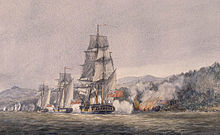Our website is made possible by displaying online advertisements to our visitors.
Please consider supporting us by disabling your ad blocker.
Portal:Islands
The Islands Portal
This is a list of the lists of islands in the world grouped by country, by continent, by body of water, and by other classifications. For rank-order lists, see the other lists of islands below. (Full article...)
Selected article –
The Battle of Valcour Island, also known as the Battle of Valcour Bay, was a naval engagement that took place on October 11, 1776, on Lake Champlain. The main action took place in Valcour Bay, a narrow strait between the New York mainland and Valcour Island. The battle is generally regarded as one of the first naval battles of the American Revolutionary War, and one of the first fought by the United States Navy. Most of the ships in the American fleet under the command of Benedict Arnold were captured or destroyed by a British force under the overall direction of General Guy Carleton. However, the American defense of Lake Champlain stalled British plans to reach the upper Hudson River valley.
The Continental Army had retreated from Quebec to Fort Ticonderoga and Fort Crown Point in June 1776 after British forces were massively reinforced. They spent the summer of 1776 fortifying those forts and building additional ships to augment the small American fleet already on the lake. General Carleton had a 9,000 man army at Fort Saint-Jean, but needed to build a fleet to carry it on the lake. The Americans, during their retreat, had either taken or destroyed most of the ships on the lake. By early October, the British fleet, which significantly outgunned the American fleet, was ready for launch. (Full article...)
Selected cuisines, dishes and foods –

Malagasy cuisine encompasses the many diverse culinary traditions of the Indian Ocean island of Madagascar. Foods eaten in Madagascar reflect the influence of Southeast Asian, African, Oceanian, Indian, Chinese and European migrants that have settled on the island since it was first populated by seafarers from Borneo between 100 CE and 500 CE. Rice, the cornerstone of the Malagasy diet, was cultivated alongside tubers and other Southeast Asian and Oceanian staples by these earliest settlers. Their diet was supplemented by foraging and hunting wild game, which contributed to the extinction of the island's bird and mammal megafauna. These food sources were later complemented by beef in the form of zebu introduced into Madagascar by East African migrants arriving around 1,000 CE.
Trade with Arab and Indian merchants and European transatlantic traders further enriched the island's culinary traditions by introducing a wealth of new fruits, vegetables, and seasonings. Throughout almost the entire island, the contemporary cuisine of Madagascar typically consists of a base of rice served with an accompaniment; in the official dialect of the Malagasy language, the rice is termed vary ([ˈvarʲ]), and the accompaniment, laoka ([ˈlokə̥]). The many varieties of laoka may be vegetarian or include animal proteins, and typically feature a sauce flavored with such ingredients as ginger, onion, garlic, tomato, vanilla, salt, curry powder, or, less commonly, other spices or herbs. In parts of the arid south and west, pastoral families may replace rice with maize, cassava, or curds made from fermented zebu milk. (Full article...)
Related articles
- List articles
- List of islands
- List of islands by area
- List of islands by highest point
- List of islands by name
- List of islands by population
- List of islands by population density
- List of archipelagos
- List of archipelagos by number of islands
- List of artificial islands
- List of divided islands
- List of fictional islands
- List of island countries
- List of islands in lakes
- List of islands named after people
- List of islands of the European Union
- List of private islands
Selected image –
Did you know –

- ... that Curtis Island has risen by 18 metres (59 ft) during the last 200 years?
- ... that the island bronze-naped pigeon is a popular food at bars and parties on São Tomé?
- ... that Saunders Island has a lava lake and is populated by penguins?
- ... that Mohawk Island is sometimes underwater?
- ... that one of the last surviving women from Rapa Nui to receive traditional facial tattoos was queen consort Ana Eva Hei?
- ... that the search for mammals on Booby Island was a bust?
General images –
Related portals
WikiProjects
Topics
Categories
Associated Wikimedia
The following Wikimedia Foundation sister projects provide more on this subject:
-
Commons
Free media repository -
Wikibooks
Free textbooks and manuals -
Wikidata
Free knowledge base -
Wikinews
Free-content news -
Wikiquote
Collection of quotations -
Wikisource
Free-content library -
Wikiversity
Free learning tools -
Wikivoyage
Free travel guide -
Wiktionary
Dictionary and thesaurus
Things to do
 |
Here are some tasks awaiting attention:
|
Web resources
- Listing of islands from the United Nations Island Directory
Previous Page Next Page




















































![Image 49The Shamanka Шаманка [ru], a holy rock in Shamanism and one of the 9 most holy places in Asia, on the westcoast of Olkhon (from List of islands of Russia)](http://upload.wikimedia.org/wikipedia/commons/thumb/2/27/Shaman_Kamen.jpg/120px-Shaman_Kamen.jpg)


















































